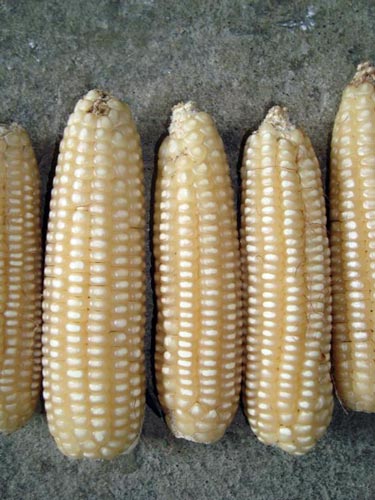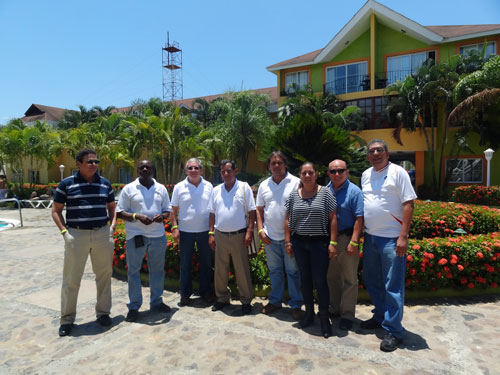 On 26-27 April 2013, the FONTAGRO “Generation and validation
On 26-27 April 2013, the FONTAGRO “Generation and validation
of drought tolerant maize varieties to stabilize and reduce mycotoxin damage resulting from climate change” project held its end-of-project meeting in La Ceiba, Honduras, along with the Central American Cooperative Program for the Improvement of Crops and Animals (PCCMCA) meeting (21-26 April). The event highlighted the advances to date, the project’s products, and recommendations for follow-up to ensure that the products reach farmers.
Since 2009, the project generated 5,000 doubled haploid (DH) lines which are currently being evaluated by CIMMYT. The populations were developed from inbred lines identified for drought tolerance, ear rot resistance, and reduced mycotoxin accumulation. The project also identified a set of inbred lines with high levels of ear rot and mycotoxin resistance. The information has been shared with project partners and other breeders for wide use, and CIMMYT will distribute these lines to interested parties. CIMMYT maize breeder Luis Narro commented on the research on diseases, ear rots in particular. “Ear rot is increasing in incidence and severity in South America. Evaluation of 18 commercial hybrids in Peru revealed ear rot incidences as high as 42% on susceptible hybrids in some locations,” he said. “Ear rot tolerant hybrids identified in this project will play an important role in mitigating the detrimental effects posed by ear rots and mycotoxin contamination. These need to be promoted to reach farmers rapidly.” As far as mycotoxins are concerned, the team also identified promising hybrids from validation trials documenting the natural incidence of mycotoxins in Peru, Colombia, and Mexico. This study showed that fumonisins are the most prevalent mycotoxin in South America (compared to aflatoxin and deoxynivalenol).
“The project has generated many products and validated some that are now being released in several countries,” said the project leader George Mahuku. Among those are four varieties released in Honduras (three white and one yellow); one white variety in Colombia; two varieties (one yellow, one white) and a yellow hybrid in Nicaragua, and three varieties (two yellow and one white) in Panama. Three hybrids outperforming the local commercial checks are under validation in Peru. Furthermore, two varieties showing the stability and rustic nature of CIMMYT-generated varieties were released in Colombia, Honduras, and Nicaragua. All the released cultivars are moderately tolerant to the tar spot complex disease which is becoming more common in Latin America.
CIMMYT maize breeder Felix San Vicente presented on the advances that have been made in breeding for drought tolerance and ear rot resistance. “We need to establish and maintain a regional network to test our products in marginal areas,” he noted. “We hope that we will be able to leverage funding from the CRP [MAIZE] to continue the validation and dissemination of these important and promising products in the region.” During the meeting, scientists presented 29 papers, 5 of which contained results from the FONTAGRO project. The papers of CIMMYT colleagues Román Gordon and Oscar Cruz were awarded for their contributions to the maize section of the project: Gordon received the first prize for his paper “Selection of maize varieties for tolerance to water stress in Panama 2010-2012,” and Cruz received the second prize for his paper on “Participatory validation of white and yellow maize varieties in two regions of Honduras.”
 The project has generally been considered very successful. “We now know which mycotoxins are important in the region and we have the products to potentially minimize the risk,” commented Mahuku. “What we need is to widely test and disseminate the products so that they reach as many farmers as possible. With a little infusion of resources, the dedication demonstrated by this group, and support from policy makers, I have no doubt that we will get there.”
The project has generally been considered very successful. “We now know which mycotoxins are important in the region and we have the products to potentially minimize the risk,” commented Mahuku. “What we need is to widely test and disseminate the products so that they reach as many farmers as possible. With a little infusion of resources, the dedication demonstrated by this group, and support from policy makers, I have no doubt that we will get there.”
During 23-25 July, FONTAGRO will hold its annual meeting (VIII Taller de Seguimiento Técnico de Proyectos FONTAGRO) in Uruguay. The “Generation and validation of drought tolerant maize varieties to stabilize and reduce mycotoxin damage resulting from climate change” is one of five projects finishing this year; its representatives were invited to present their results and compete for a financial award given to the best project. If the project wins, the financial resources could help with continued and wider validation of products generated by this project.
 Nutrition, health and food security
Nutrition, health and food security